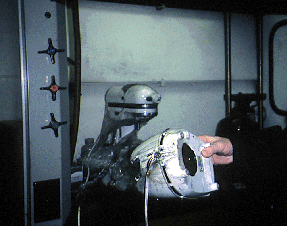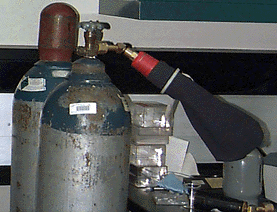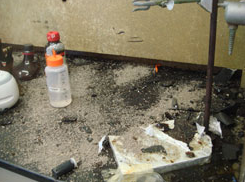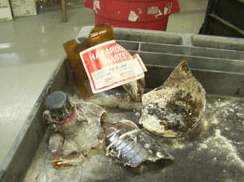A UK researcher was mixing carbon with approximately 500 milliliters of hexane in a regular household blender in a fume hood. The flash point of hexane is -21 degrees Celsius. The container for the blender developed a leak. Hexane dripped on to the blender motor and caused a small explosion and fire. Household blenders provide a source of ignition for flammable vapors and are not appropriate for laboratory use.
Lessons Learned
Household Blenders Not Appropriate for Lab Use


Dry Ice Maker Rupture
A UK researcher was injured when using a carbon dioxide cylinder with a device called a Frigimat Jr. (Bel-Air Products, Product No. F38886-0000) to form flaked dry ice. This device includes a brass nozzle with a polypropylene cone, clamp, and cloth bag. It screws directly into cylinder of liquid carbon dioxide. The bag is then secured on the cone with the clamp. Manufacturer's instructions call for the cylinder valve to be opened about 3/4 turn and the compressed liquid carbon dioxide expands into the bag. On this occasion the researcher opened the valve of they cylinder approximately 3 or 4 turns and a mixture of solid and gas forms of carbon dioxide were released at high pressure into the researcher's face. The cylinder valve popped and the cone of the dry ice appliance was cracked. His prescriptive safety glasses were knocked off his face due to the extreme impact. The researcher was taken to the emergency room where he was treated for traumatic injury, corneal abrasion, and cold burn.

Spill + Slip = UK Lab Worker Injury
A UK researcher was testing the pH of a four liter container of hazardous waste when the bottle fell and burst. The waste contained acetonitrile, methanol, ether, mineral oil, water, thionyl chloride, acetic acid, acetyl chloride, and potassium hydroxide. The researcher fell in the slippery liquid chemicals, hitting his head extremely hard on the floor. The entire side of his body was saturated in the liquid solution. He took off his lab coat and shirt and rinsed his eyes in the faucet-mounted emergency eyewash located in the lab. With the assistance of a staff member across the hall, he walked to the emergency room to be treated for lacerations and eye burns.

Incompatibles Cause Explosion on UK Campus
An explosion occurred in a fume hood when a researcher mixed the waste products of nitric acid and ethanol. The lid of the waste container was capped and the bottle over pressurized and exploded almost immediately. The researcher was wearing safety glasses and a lab coat. However, the fume hood sash was above the working height as indicated by the yellow sticker. If the sash had been placed at the correct working height, the burns and lacerations that the researcher received would have been reduced.
Always keep the fume hood sash at the working height or closed when active work is not required in the fume hood.


Piranha Solution Explosion
A four liter bottle of Piranha waste solution exploded in the Environmental Quality Management Center. It was unclear exactly what caused the explosion, but it was theorized that the contents were not mixed well or had contamination in the bottle. The transporting of the bottle to the facility added enough energy to cause more off-gassing and over pressurize the container. No one was injured during the explosion.
If piranha solution is going to be used in the laboratory, it is recommended that the bottle be capped with a vented lid. These lids allow the container to “breath”. This will help prevent over pressurization of the container. These lids are also leak-proof. These lids can be obtained from Environmental Management, 323-6280.
